Individual and Interactive Influences of Anthropogenic and Ecological Factors on Forest PM2.5 Concentrations at an Urban Scale
Abstract
:1. Introduction
2. Materials and Methods
2.1. Overview
2.2. Developing a Multiple-Source Spatial Database
2.3. Calculation of PM2.5 Concentrations
2.3.1. Satellite-Derived Aerosol Optical Depth (AOD)
2.3.2. Calculation of PM2.5 from AOD Data
2.4. Spatial Statistical Analysis
2.5. Geographical Detector Model Description
3. Results
3.1. Spatial Distribution Pattern of Urban Forest PM2.5 Concentrations
3.2. Population Density and Stand Structure
3.3. Influences of Anthropogenic and Ecological Factors on Urban Forest PM2.5 Concentrations
4. Discussion
4.1. Significance
4.2. Individual Functions
4.3. Interactive Functions
4.4. Limitations and Advantages of the Study
5. Conclusions
Supplementary Materials
Acknowledgments
Author Contributions
Conflicts of Interest
References
- Wu, J.S.; Yao, F.; Li, W.F.; Si, M.L. Viirs-based remote sensing estimation of ground-level PM2.5 concentrations in beijing-tianjin-hebei: A spatiotemporal statistical model. Remote Sens. Environ. 2016, 184, 316–328. [Google Scholar] [CrossRef]
- Pope, C.A.; Burnett, R.T.; Thun, M.J.; Calle, E.E.; Krewski, D.; Ito, K.; Thurston, G.D. Lung cancer, cardiopulmonary mortality, and long-term exposure to fine particulate air pollution. J. Am. Med. Assoc. 2002, 287, 1132–1141. [Google Scholar] [CrossRef]
- Kappos, A.D.; Bruckmann, P.; Eikmann, T.; Englert, N.; Heinrich, U.; Hoppe, P.; Koch, E.; Krause, G.H.M.; Kreyling, W.G.; Rauchfuss, K.; et al. Health effects of particles in ambient air. Int. J. Hyg. Environ. Health 2004, 207, 399–407. [Google Scholar] [CrossRef] [PubMed]
- Solomon, S.; Qin, D.; Manning, M.; Chen, Z.; Marquis, M.; Averyt, K.B.; Tignor, M.; Miller, H.L. Contribution of Working Group I to the Fourth Assessment Report of the Intergovernmental Panel on Climate Change, 2007; Cambridge University Press: Cambridge, UK; New York, NY, USA, 2007; p. 976. [Google Scholar]
- Liu, Z.; Sun, Y.; Li, L.; Wang, Y. Particle mass concentrations and size distribution during and after the Beijing Olympic games. Huan jing ke xue = Huanjing kexue 2011, 32, 913–923. [Google Scholar] [PubMed]
- Chen, B.; Lu, S.W.; Zhao, Y.G.; Li, S.N.; Yang, X.B.; Wang, B.; Zhang, H.J. Pollution remediation by urban forests: PM2.5 reduction in Beijing, China. Pol. J. Environ. Stud. 2016, 25, 1873–1881. [Google Scholar] [CrossRef]
- Rissanen, T.; Hyotylainen, T.; Kallio, M.; Kronholm, J.; Kulmala, M.; Rikkola, M.L. Characterization of organic compounds in aerosol particles from a coniferous forest by GC-MS. Chemosphere 2006, 64, 1185–1195. [Google Scholar] [CrossRef] [PubMed]
- Pio, C.; Alves, C.; Duarte, A. Organic components of aerosols in a forested area of central Greece. Atmos. Environ. 2001, 35, 389–401. [Google Scholar] [CrossRef]
- Tiwary, A.; Sinnett, D.; Peachey, C.; Chalabi, Z.; Vardoulakis, S.; Fletcher, T.; Leonardi, G.; Grundy, C.; Azapagic, A.; Hutchings, T.R. An integrated tool to assess the role of new planting in PM10 capture and the human health benefits: A case study in London. Environ. Pollut. 2009, 157, 2645–2653. [Google Scholar] [CrossRef] [PubMed]
- Gagne, S.A.; Sherman, P.J.; Singh, K.K.; Meentemeyer, R.K. The effect of human population size on the breeding bird diversity of urban regions. Biodivers. Conserv. 2016, 25, 653–671. [Google Scholar] [CrossRef]
- Jin, S.J.; Guo, J.K.; Wheeler, S.; Kan, L.Y.; Che, S.Q. Evaluation of impacts of trees on PM2.5 dispersion in urban streets. Atmos. Environ. 2014, 99, 277–287. [Google Scholar] [CrossRef]
- Liu, X.H.; Yu, X.X.; Zhang, Z.M. PM2.5 concentration differences between various forest types and its correlation with forest structure. Atmosphere 2015, 6, 1801–1815. [Google Scholar] [CrossRef]
- Shu, J.; Dearing, J.A.; Morse, A.P.; Yu, L.Z.; Yuan, N. Determining the sources of atmospheric particles in Shanghai, China, from magnetic and geochemical properties. Atmos. Environ. 2001, 35, 2615–2625. [Google Scholar] [CrossRef]
- Gao, G.J.; Sun, F.B.; Thao, N.T.T.; Lun, X.X.; Yu, X.X. Different concentrations of TSP, PM10, PM2.5, and PM1 of several urban forest types in different seasons. Pol. J. Environ. Stud. 2015, 24, 2387–2395. [Google Scholar] [CrossRef]
- Hu, Y.; Xia, C.; Li, S.; Ward, M.P.; Luo, C.; Gao, F.; Wang, Q.; Zhang, S.; Zhang, Z. Assessing environmental factors associated with regional schistosomiasis prevalence in Anhui province, Peoples’ Republic of China using a geographical detector method. Infect. Dis. Poverty 2017, 6, 87. [Google Scholar] [CrossRef] [PubMed]
- Saebo, A.; Popek, R.; Nawrot, B.; Hanslin, H.M.; Gawronska, H.; Gawronski, S.W. Plant species differences in particulate matter accumulation on leaf surfaces. Sci. Total Environ. 2012, 427, 347–354. [Google Scholar] [CrossRef] [PubMed]
- Ord, J.K.; Getis, A. Local spatial autocorrelation statistics: Distributional issues and an application. Geogr. Anal. 1995, 27, 286–306. [Google Scholar] [CrossRef]
- Barrell, J.; Grant, J. Detecting hot and cold spots in a seagrass landscape using local indicators of spatial association. Landsc. Ecol. 2013, 28, 2005–2018. [Google Scholar] [CrossRef]
- Lei, X.D.; Tang, M.P.; Lu, Y.C.; Hong, L.X.; Tian, D.L. Forest inventory in China: Status and challenges. Int. For. Rev. 2009, 11, 52–63. [Google Scholar] [CrossRef]
- He, J.; Yang, K. China Meteorological Forcing Dataset; Cold and Arid Regions Science Data Center at Lanzhou: Lanzhou, China, 2011; Available online: http://westdc.westgis.ac.cn/data/7a35329c-c53f-4267-aa07-e0037d913a21 (accessed on 1 March 2018).
- Vermote, E.F.; Tanre, D.; Deuze, J.L.; Herman, M.; Morcrette, J.J. Second simulation of the satellite signal in the solar spectrum, 6s: An overview. IEEE Trans. Geosci. Remote Sens. 1997, 35, 675–686. [Google Scholar] [CrossRef]
- Chen, Y.P.; Han, W.H.; Chen, S.Z.; Tong, L. Estimating ground-level PM2.5 concentration using Landsat 8 in Chengdu, China. In Remote Sensing of the Atmosphere, Clouds, and Precipitation v; Im, E., Yang, S., Zhang, P., Eds.; SPIE: Bellingham, WA, USA, 2014; Volume 9259. [Google Scholar]
- Levy, R.C.; Remer, L.A.; Mattoo, S.; Vermote, E.F.; Kaufman, Y.J. Second-generation operational algorithm: Retrieval of aerosol properties over land from inversion of moderate resolution imaging spectroradiometer spectral reflectance. J. Geophys. Res. Atmos. 2007, 112. [Google Scholar] [CrossRef]
- Koelemeijer, R.B.A.; Homan, C.D.; Matthijsen, J. Comparison of spatial and temporal variations of aerosol optical thickness and particulate matter over Europe. Atmos. Environ. 2006, 40, 5304–5315. [Google Scholar] [CrossRef]
- Lin, C.Q.; Li, Y.; Yuan, Z.B.; Lau, A.K.H.; Li, C.C.; Fung, J.C.H. Using satellite remote sensing data to estimate the high-resolution distribution of ground-level PM2.5. Remote Sens. Environ. 2015, 156, 117–128. [Google Scholar] [CrossRef]
- He, Q.S.; Li, C.C.; Geng, F.H.; Zhou, G.Q.; Gao, W.; Yu, W.; Li, Z.K.; Du, M.B. A parameterization scheme of aerosol vertical distribution for surface-level visibility retrieval from satellite remote sensing. Remote Sens. Environ. 2016, 181, 1–13. [Google Scholar] [CrossRef]
- Jung, J.; Lee, H.; Kim, Y.J.; Liu, X.; Zhang, Y.; Gu, J.; Fan, S. Aerosol chemistry and the effect of aerosol water content on visibility impairment and radiative forcing in Guangzhou during the 2006 Pearl River Delta campaign. J. Environ. Manag. 2009, 90, 3231–3244. [Google Scholar] [CrossRef] [PubMed]
- Huang, W.X.; Cheng, X.W. Multiple regression method for estimating concentration of PM2.5 using remote sensing and meteorological data. J. Environ. Prot. Ecol. 2017, 18, 417–424. [Google Scholar]
- Wang, Z.F.; Chen, L.F.; Tao, J.H.; Zhang, Y.; Su, L. Satellite-based estimation of regional particulate matter (PM) in Beijing using vertical-and-RH correcting method. Remote Sens. Environ. 2010, 114, 50–63. [Google Scholar] [CrossRef]
- Eck, J.; Chainey, S.; Cameron, J.; Wilson, R. Mapping Crime: Understanding Hotspots; U.S. Department of Justice, Office of Justice Programs: Washington, DC, USA, 2005.
- Kara, C.; Akcit, N. Traffic accident analysis using Gis: A case study of Kyrenia city. In Third International Conference on Remote Sensing and Geoinformation of the Environment; Hadjimitsis, D.G., Themistocleous, K., Michaelides, S., Papadavid, G., Eds.; SPIE: Bellingham, WA, USA, 2015; Volume 9535. [Google Scholar]
- Mei, Z.X.; Xu, S.J.; Ouyang, J. Spatio-temporal association analysis of county potential in the Pearl River Delta during 1990–2009. J. Geogr. Sci. 2015, 25, 319–336. [Google Scholar] [CrossRef]
- Stopka, T.J.; Krawczyk, C.; Gradziel, P.; Geraghty, E.M. Use of spatial epidemiology and hot spot analysis to target women eligible for prenatal women, infants, and children services. Am. J. Public Health 2014, 104, S183–S189. [Google Scholar] [CrossRef] [PubMed]
- Hu, Y.; Wang, J.; Li, X.; Ren, D.; Zhu, J. Geographical detector-based risk assessment of the under-five mortality in the 2008 Wenchuan Earthquake, China. PLoS ONE 2011, 6, e21427. [Google Scholar] [CrossRef] [PubMed]
- Du, Z.Q.; Xu, X.M.; Zhang, H.; Wu, Z.T.; Liu, Y. Geographical detector-based identification of the impact of major determinants on Aeolian Desertification Risk. PLoS ONE 2016, 11, e0151331. [Google Scholar] [CrossRef] [PubMed]
- Wang, J.F.; Li, X.H.; Christakos, G.; Liao, Y.L.; Zhang, T.; Gu, X.; Zheng, X.Y. Geographical detectors-based health risk assessment and its application in the neural tube defects study of the Heshun region, China. Int. J. Geogr. Inf. Sci. 2010, 24, 107–127. [Google Scholar] [CrossRef]
- Cao, Z.; Liu, T.; Li, X.; Wang, J.; Lin, H.L.; Chen, L.L.; Wu, Z.F.; Ma, W.J. Individual and interactive effects of socio-ecological factors on dengue fever at fine spatial scale: A geographical detector-based analysis. Int. J. Environ. Res. Public Health 2017, 14, 795. [Google Scholar] [CrossRef] [PubMed]
- Zhang, T.H.; Liu, G.; Zhu, Z.M.; Gong, W.; Ji, Y.X.; Huang, Y.S. Real-time estimation of satellite-derived PM2.5 based on a semi-physical geographically weighted regression model. Int. J. Environ. Res. Public Health 2016, 13, 974. [Google Scholar] [CrossRef] [PubMed]
- Cisneros, R.; Schweizer, D.; Preisler, H.; Bennett, D.H.; Shaw, G.; Bytnerowicz, A. Spatial and seasonal patterns of particulate matter less than 2.5 microns in the sierra Nevada Mountains, California. Atmos. Pollut. Res. 2014, 5, 581–590. [Google Scholar] [CrossRef]
- Halsey, L.A.; Vitt, D.H.; Zoltai, S.C. Disequilibrium response of permafrost in boreal continental Western Canada to climate change. Clim. Chang. 1995, 30, 57–73. [Google Scholar] [CrossRef]
- Stone, J.O. Air pressure and cosmogenic isotope production. J. Geophys. Res.-Solid Earth 2000, 105, 23753–23759. [Google Scholar] [CrossRef]
- Körner, C. The use of ‘altitude’ in ecological research. Trends Ecol. Evol. 2007, 22, 569–574. [Google Scholar] [CrossRef] [PubMed]
- Zhang, Z.M.; Liu, J.K.; Wu, Y.N.; Yan, G.X.; Zhu, L.J.; Yu, X.X. Multi-scale comparison of the fine particle removal capacity of urban forests and wetlands. Sci. Rep. 2017, 7, 46214. [Google Scholar] [CrossRef] [PubMed]
- Nguyen, T.; Yu, X.X.; Zhang, Z.M.; Liu, M.M.; Liu, X.H. Relationship between types of urban forest and PM2.5 capture at three growth stages of leaves. J. Environ. Sci. 2015, 27, 33–41. [Google Scholar] [CrossRef] [PubMed]
- Yang, J.; Xie, B.Z.; Shi, H.; Wang, H.X.; Wang, Y.H. Study on capturing PM2.5 capability of tree species in different functional areas. In Proceedings of the 2015 International Conference on Industrial Technology and Management Science; Zhao, J., Ed.; Atlantis Press: Paris, France, 2015; Volume 34, pp. 585–588. [Google Scholar]
- Fowler, D.; Cape, J.N.; Unsworth, M.H. Deposition of atmospheric pollutants on forests. Philos. Trans. R. Soc. Lond. Ser. B Biol. Sci. 1989, 324, 247–265. [Google Scholar] [CrossRef]
- Beckett, K.P.; Freer-Smith, P.H.; Taylor, G. Urban woodlands: Their role in reducing the effects of particulate pollution. Environ. Pollut. 1998, 99, 347–360. [Google Scholar] [CrossRef]
- Hwang, H.-J.; Yook, S.-J.; Ahn, K.-H. Experimental investigation of submicron and ultrafine soot particle removal by tree leaves. Atmos. Environ. 2011, 45, 6987–6994. [Google Scholar] [CrossRef]
- Kim, K.H.; Kim, M.Y.; Hong, S.M.; Youn, Y.H.; Hwang, S.J. The effects of wind speed on the relative relationships between different sized-fractions of airborne particles. Chemosphere 2005, 59, 929–937. [Google Scholar] [CrossRef] [PubMed]
- Lou, C.R.; Liu, H.Y.; Li, Y.F.; Li, Y.L. Socioeconomic drivers of PM2.5 in the accumulation phase of air pollution episodes in the Yangtze River Delta of China. Int. J. Environ. Res. Public Health 2016, 13, 928. [Google Scholar] [CrossRef] [PubMed]
- Beelen, R.; Hoek, G.; Pebesma, E.; Vienneau, D.; de Hoogh, K.; Briggs, D.J. Mapping of background air pollution at a fine spatial scale across the European Union. Sci. Total Environ. 2009, 407, 1852–1867. [Google Scholar] [CrossRef] [PubMed]
- Hoek, G.; Beelen, R.; de Hoogh, K.; Vienneau, D.; Gulliver, J.; Fischer, P.; Briggs, D. A review of land-use regression models to assess spatial variation of outdoor air pollution. Atmos. Environ. 2008, 42, 7561–7578. [Google Scholar] [CrossRef]
- Beckett, K.P.; Freer-Smith, P.H.; Taylor, G. Particulate pollution capture by urban trees: Effect of species and windspeed. Glob. Chang. Biol. 2000, 6, 995–1003. [Google Scholar] [CrossRef]
- Baxter, L.K.; Burke, J.; Lunden, M.; Turpin, B.J.; Rich, D.Q.; Thevenet-Morrison, K.; Hodas, N.; Ozkaynak, H. Influence of human activity patterns, particle composition, and residential air exchange rates on modeled distributions of PM2.5 exposure compared with central-site monitoring data. J. Expo. Sci. Environ. Epidemiol. 2013, 23, 241–247. [Google Scholar] [CrossRef] [PubMed]
- Bai, H.; Li, D.; Ge, Y.; Wang, J. Detecting nominal variables’ spatial associations using conditional probabilities of neighboring surface objects’ categories. Inf. Sci. 2016, 329, 701–718. [Google Scholar] [CrossRef]
- Tang, L.N.; Shao, G.F.; Piao, Z.J.; Dai, L.M.; Jenkins, M.A.; Wang, S.X.; Wu, G.; Wu, J.G.; Zhao, J.Z. Forest degradation deepens around and within protected areas in east Asia. Biol. Conserv. 2010, 143, 1295–1298. [Google Scholar] [CrossRef]
- Zhao, J.Z.; Liu, X.; Dong, R.C.; Shao, G.F. Landsenses ecology and ecological planning towards sustainable development. Int. J. Sustain. Dev. World Ecol. 2016, 23, 293–297. [Google Scholar] [CrossRef]
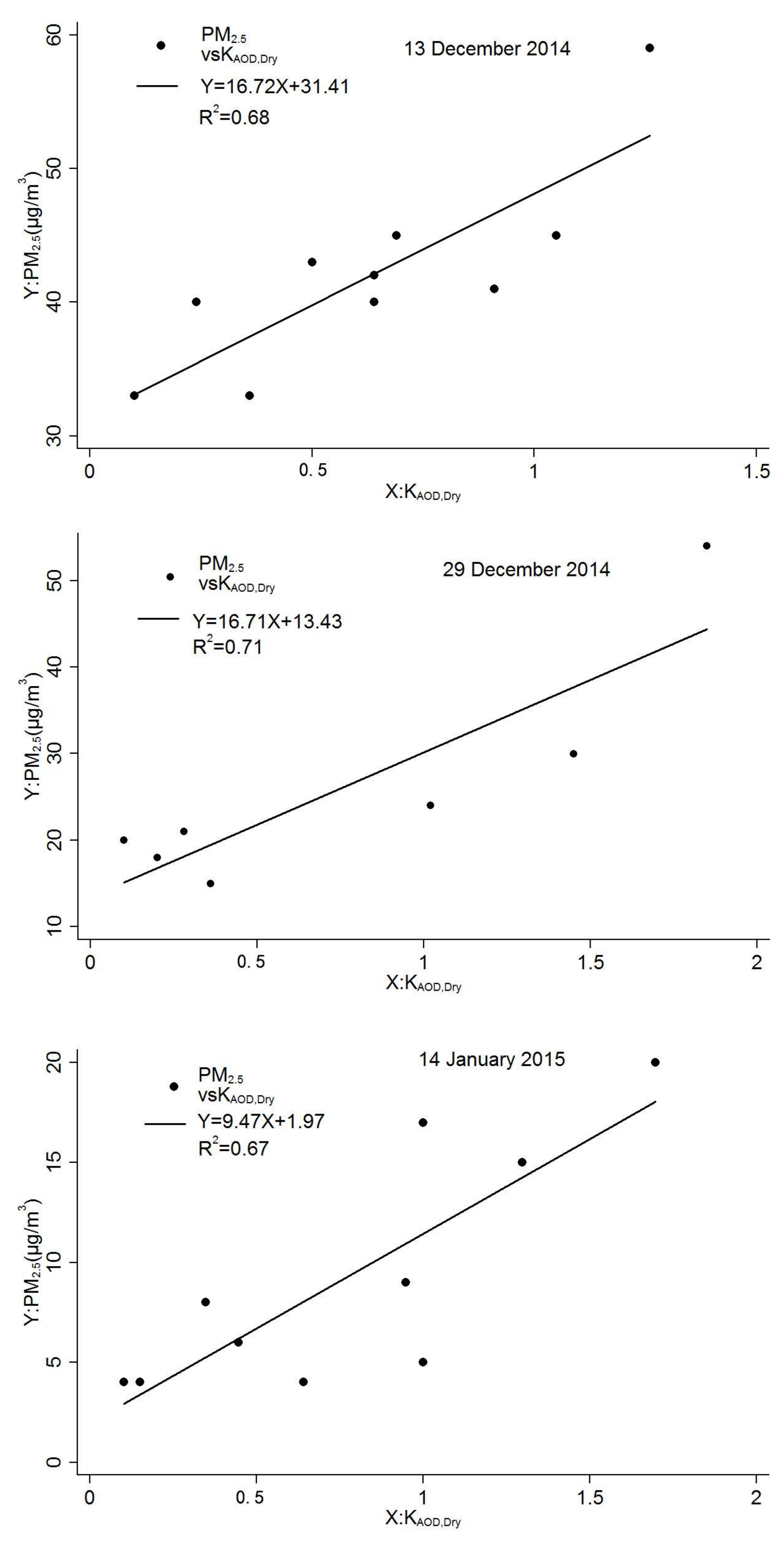
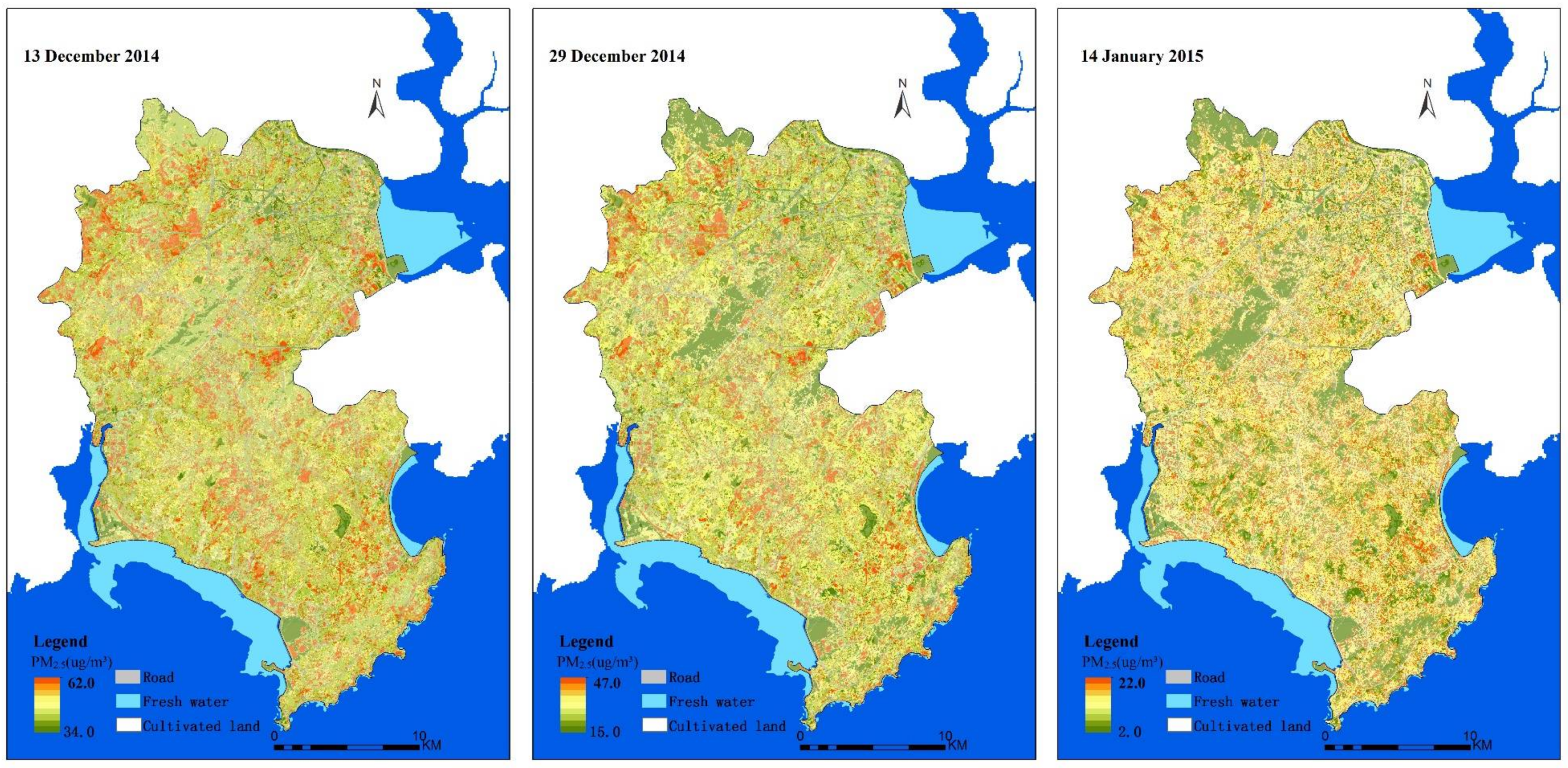
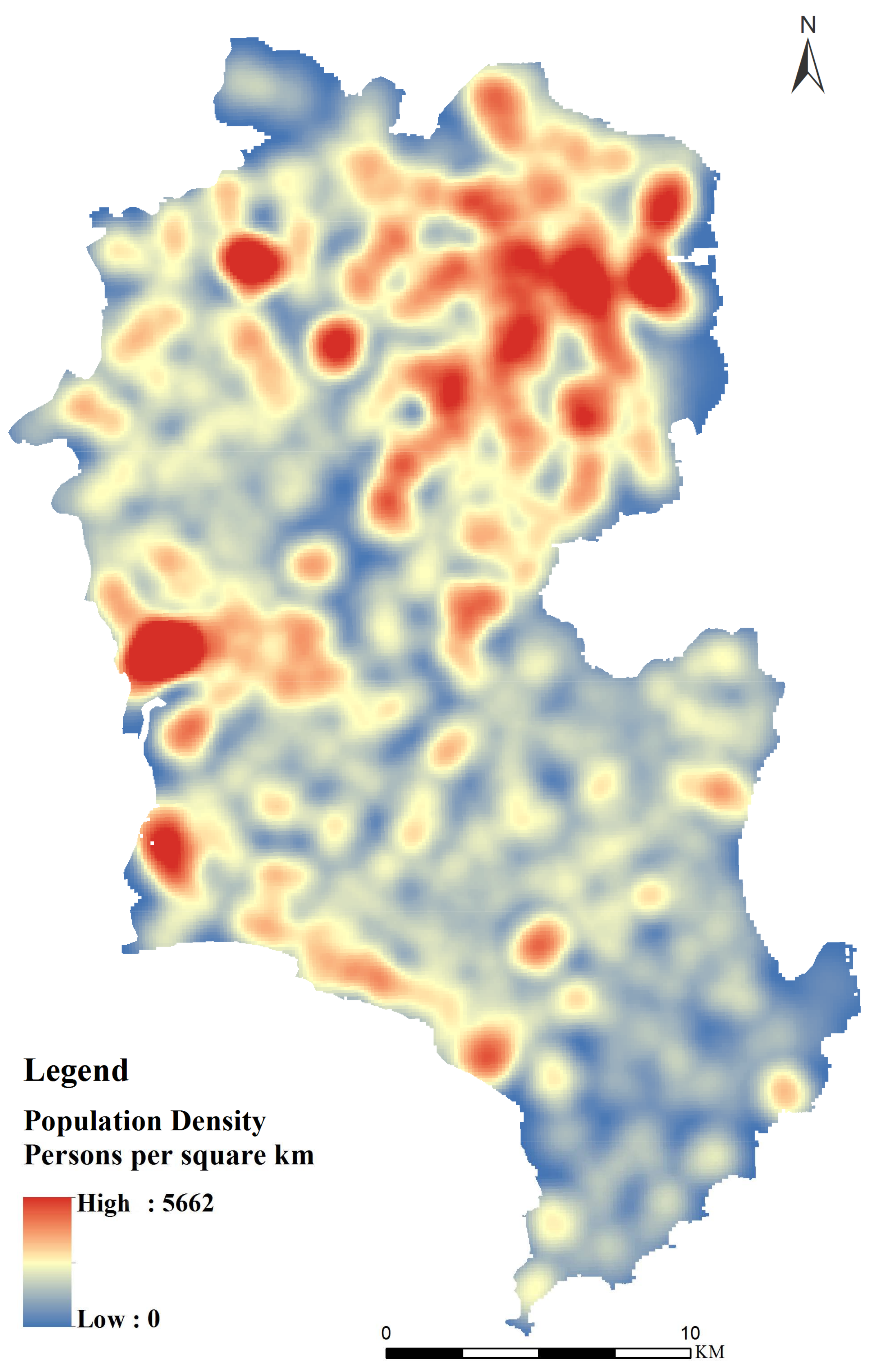
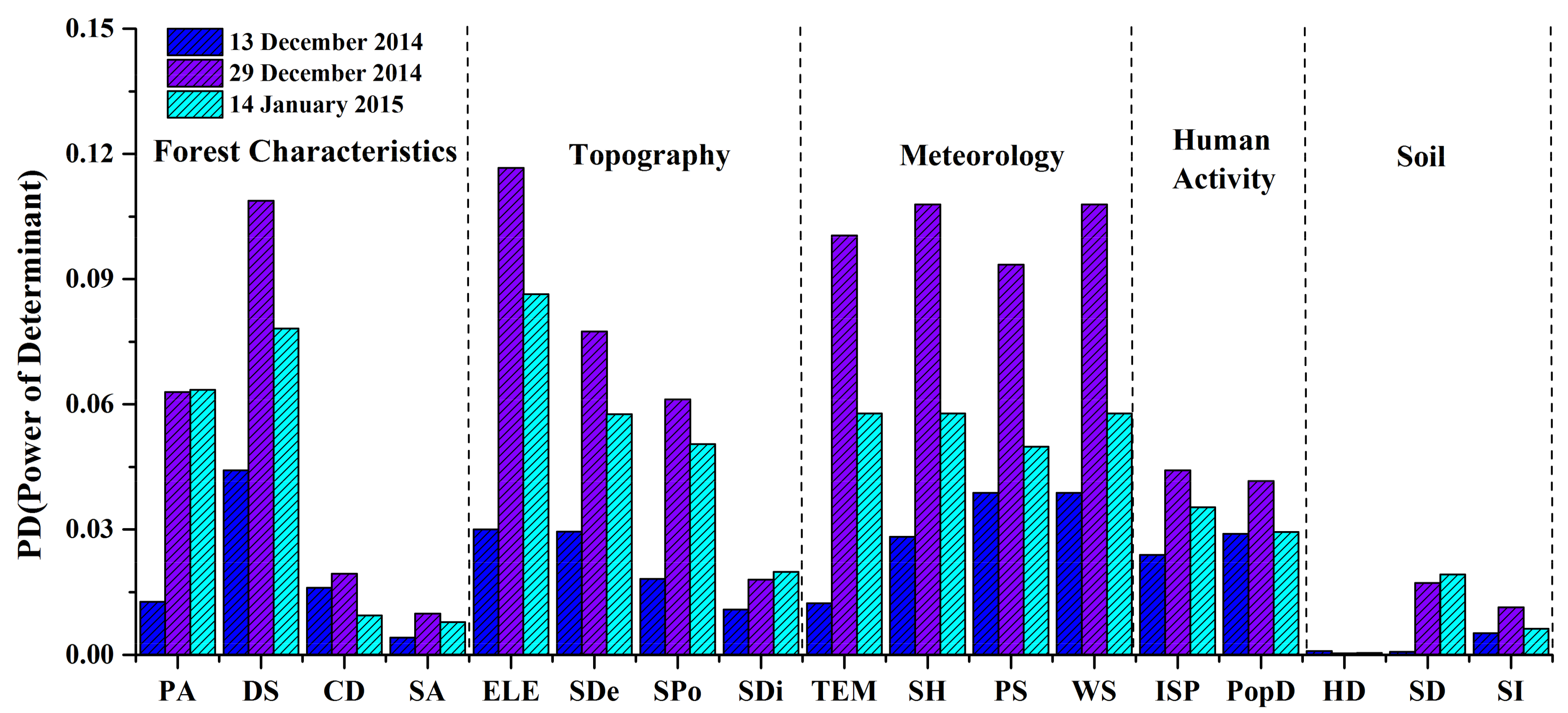
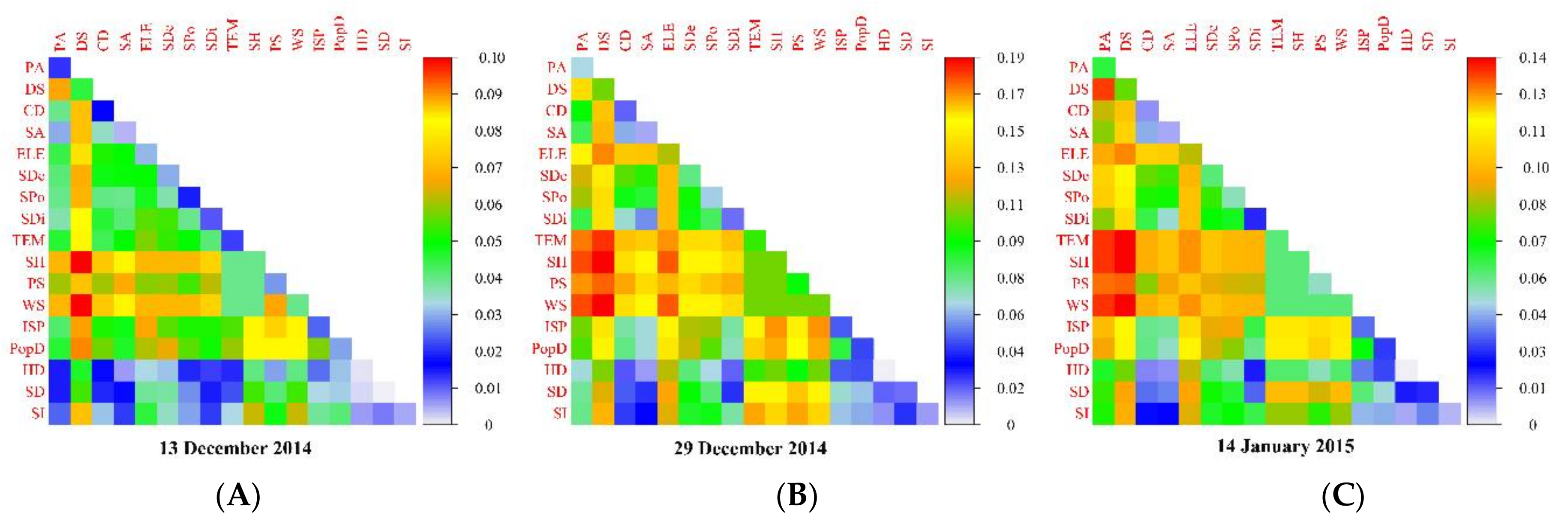
| Time | 13 December 2014 | 29 December 2014 | 14 January 2015 |
|---|---|---|---|
| Moran’s I Index | 0.192 ** | 0.336 ** | 0.185 ** |
| z-score | 63.412 | 110.860 | 95.761 |
| Pattern | Clustered | Clustered | Clustered |
| Factors | Factor Composition | 13 December 2014 | 29 December 2014 | 14 January 2015 |
|---|---|---|---|---|
| Forest Characteristics | PA | 0.013 | 0.063 | 0.063 |
| DS | 0.044 | 0.109 | 0.078 | |
| CD | 0.016 | 0.019 | 0.009 | |
| SA | 0.004 | 0.010 | 0.008 | |
| Soil | SI | 0.005 | 0.011 | 0.006 |
| SD | 0.001 | 0.017 | 0.019 | |
| HD | 0.001 | 0.001 | 0.001 | |
| Topography | ELE | 0.030 | 0.117 | 0.086 |
| SDe | 0.029 | 0.077 | 0.058 | |
| SPo | 0.018 | 0.061 | 0.050 | |
| SDi | 0.011 | 0.018 | 0.020 | |
| Human Activity | PopD | 0.029 | 0.042 | 0.029 |
| ISP | 0.024 | 0.044 | 0.035 | |
| Meteorological factors | TEM | 0.012 | 0.100 | 0.057 |
| SH | 0.028 | 0.107 | 0.057 | |
| PS | 0.038 | 0.093 | 0.049 | |
| WS | 0.038 | 0.107 | 0.057 |
© 2018 by the authors. Licensee MDPI, Basel, Switzerland. This article is an open access article distributed under the terms and conditions of the Creative Commons Attribution (CC BY) license (http://creativecommons.org/licenses/by/4.0/).
Share and Cite
Yun, G.; Zuo, S.; Dai, S.; Song, X.; Xu, C.; Liao, Y.; Zhao, P.; Chang, W.; Chen, Q.; Li, Y.; et al. Individual and Interactive Influences of Anthropogenic and Ecological Factors on Forest PM2.5 Concentrations at an Urban Scale. Remote Sens. 2018, 10, 521. https://doi.org/10.3390/rs10040521
Yun G, Zuo S, Dai S, Song X, Xu C, Liao Y, Zhao P, Chang W, Chen Q, Li Y, et al. Individual and Interactive Influences of Anthropogenic and Ecological Factors on Forest PM2.5 Concentrations at an Urban Scale. Remote Sensing. 2018; 10(4):521. https://doi.org/10.3390/rs10040521
Chicago/Turabian StyleYun, Guoliang, Shudi Zuo, Shaoqing Dai, Xiaodong Song, Chengdong Xu, Yilan Liao, Peiqiang Zhao, Weiyin Chang, Qi Chen, Yaying Li, and et al. 2018. "Individual and Interactive Influences of Anthropogenic and Ecological Factors on Forest PM2.5 Concentrations at an Urban Scale" Remote Sensing 10, no. 4: 521. https://doi.org/10.3390/rs10040521






